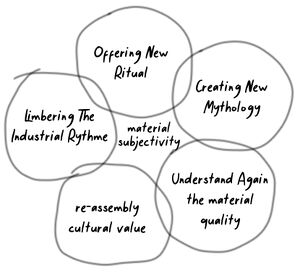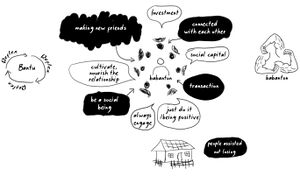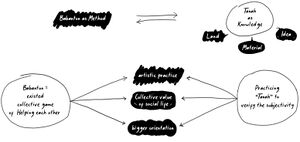Tanah
tanah
For the people of (the Indonesian district) Jatiwangi, tanah has been the essential element in their lives for over a hundred years. Along with agriculture, the production of roof tiles and bricks had been the main economic activity in the region, up until the early 2000s. When Jatiwangi art Factory (JaF) was founded in 2005, the roof tile industry was declining. The declining number of traditional brick factories was occurring alongside state development projects to advance Jatiwangi as a large manufacturing region, in response to larger free market demands. Slowly but surely, the tanah of Jatiwangi that was characteristic
of the ingenious hands of the people—a solid identity of Jatiwangi—shifted its role to a land of new concrete factories. Most of the agricultural land was changed from productive food cultivation into land for housing, shopping, and many other infrastructures that come with urban development and growth.
Arief Yudi, co-founder of JaF, often asks guests, colleagues, and friends, ‘What do you think an ideal city should be like?’ This question, a strange one for cosmopolites who have no attachment to a single domain or territory, quietly problematizes the question of what is ‘ideal’. It is a pivotal question for those who were born, live, work, and will die in the same place, here in Jatiwangi. Issues revolving around dignity, identity, and a way of life in the space we occupy in the present and future is at stake. This is firmly intertwined with JaF’s artistic practices and even its very existence.
There is no other choice for the people of Jatiwangi but to defend their tanah—their land, their earth, their soil, their ground—that has provided for life and its own ecosystem for decades. Many collective methods, work forms, performative acts, understandings, and artistic practices have made tanah their centre as well as their subject. In these processes, tanah is being shaped, positioned, redefined, redignified, and its status restored. By defending tanah, the people of Jatiwangi prevail as a collective subject that remains whole in the face of state development projects that neglect the voices of this community. Up to this day, JaF’s practices and efforts are still expanding. One
of them is Kota Terakota (Terracotta City), the result
of saling bantu (mutual assistance) between various parties and policy makers.


